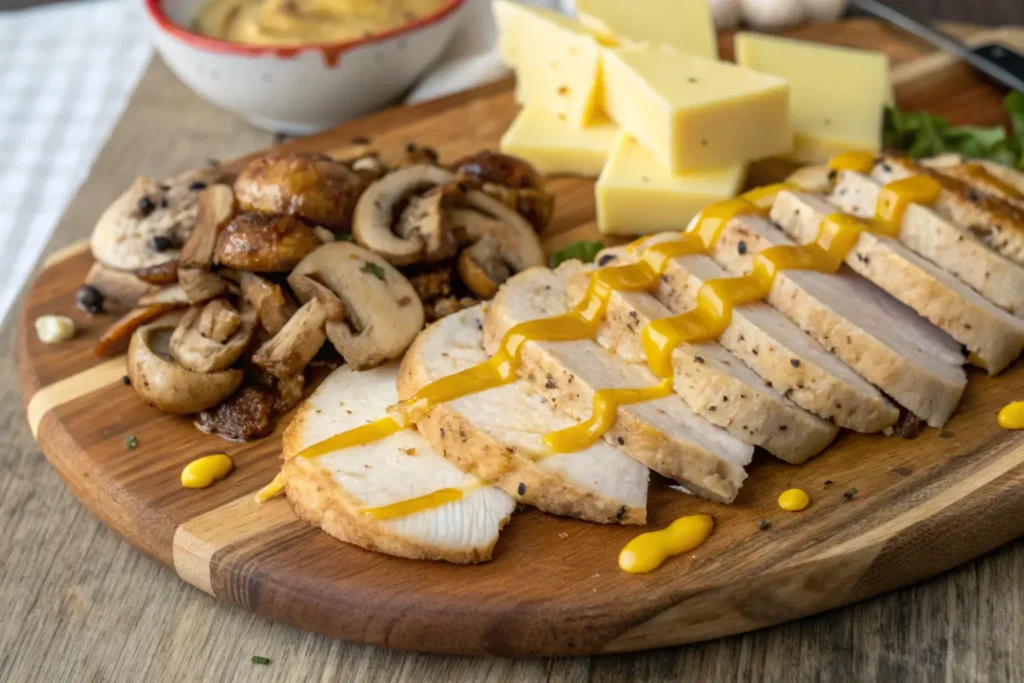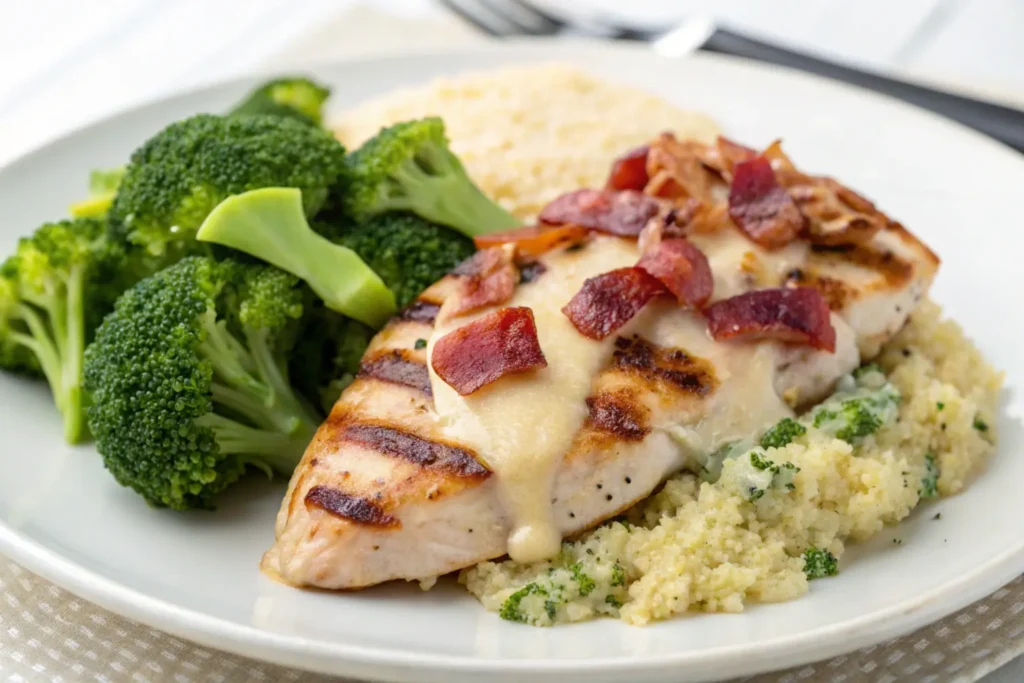Alice Springs Chicken is a popular dish loved for its rich flavor, gooey cheese, and tender chicken breast. But have you ever wondered how many calories in Alice Springs Chicken? This article dives into its caloric content, nutritional profile, preparation methods, and even some tips to make it a healthier option. Whether you’re calorie-counting or just curious about your favorite dish, here’s everything you need to know.
Understanding the Caloric Content of Alice Springs Chicken
What is Alice Springs Chicken?

Alice Springs Chicken is a signature dish from a well-known restaurant chain. It features grilled chicken breast topped with melted cheese, sautéed mushrooms, and a drizzle of honey mustard sauce. Known for its savory and indulgent flavor, it’s often served with sides like fries or vegetables, adding to its overall appeal.
Origin and Popularity
The dish was named after Alice Springs, a town in Australia, reflecting the chain’s roots. It quickly gained fame for its blend of smoky, creamy, and tangy flavors. People often associate it with comfort food that pairs well with casual dining or celebratory meals.
Typical Ingredients Used
The key ingredients in Alice Springs Chicken include:
- Chicken breast: The protein-packed centerpiece of the dish.
- Cheese: Usually cheddar or Monterey Jack, providing a rich, gooey texture.
- Mushrooms: Sautéed mushrooms add an earthy flavor.
- Honey mustard sauce: A tangy-sweet glaze that ties the flavors together.
These ingredients contribute significantly to the calorie count and nutritional profile of the dish.
Caloric Content in Different Serving Sizes
Understanding how many calories in Alice Springs Chicken begins with examining portion sizes. Serving size plays a crucial role in determining the caloric value, as even slight differences can impact your daily intake. Below, we’ll break down the caloric content of two common serving sizes: 5 oz and 8 oz portions.
5 oz Serving
A 5 oz portion of Alice Springs Chicken is a smaller serving, ideal for lighter meals or those looking to manage calorie intake. On average, this portion contains:
- Calories: Approximately 380-450, depending on the preparation method and toppings.
- Protein: Around 35-40 grams, making it a protein-dense choice.
- Fat: Between 20-25 grams, largely from the cheese and honey mustard sauce.
- Carbohydrates: Roughly 5-10 grams, influenced by the sauce and optional sides.
While the calorie count may seem reasonable, the fats and sodium levels can add up quickly due to the toppings.
8 oz Serving
The 8 oz serving size is more substantial and often ordered by those with hearty appetites. This portion contains:
- Calories: Around 600-700, making it a heavier meal.
- Protein: Approximately 50-55 grams, excellent for meeting protein goals.
- Fat: Roughly 30-35 grams, significantly higher due to the increased portion of cheese and sauce.
- Carbohydrates: Around 8-15 grams, depending on additional ingredients.
For anyone managing their dietary intake, this larger serving size might be better suited as a treat rather than an everyday meal.
Detailed Nutritional Information
Beyond the calorie count, understanding the nutritional profile of Alice Springs Chicken provides a clearer picture of its impact on your diet. By breaking it down into macronutrients and micronutrients, you can see how this dish fits into your daily nutritional needs.
Macronutrients
Macronutrients are the foundation of any meal, consisting of proteins, fats, and carbohydrates. Alice Springs Chicken offers a balanced combination of these components:
| Portion Size | Calories | Protein (g) | Fat (g) | Carbohydrates (g) |
|---|---|---|---|---|
| 5 oz | 380-450 | 35-40 | 20-25 | 5-10 |
| 8 oz | 600-700 | 50-55 | 30-35 | 8-15 |
- Protein: A standout feature of this dish, it delivers approximately 35-55 grams of protein per serving. The chicken breast is lean and supports muscle repair and growth.
- Fat: The fat content varies, with 20-35 grams per serving, depending on portion size. This fat primarily comes from cheese, honey mustard sauce, and cooking oil, contributing to its rich taste.
- Carbohydrates: At 5-15 grams per serving, carbohydrates are relatively low, making this dish suitable for low-carb diets. The honey mustard sauce adds most of the carbs, so portion control can help reduce intake.
Macronutrient balance is crucial for energy and overall health. While Alice Springs Chicken is protein-rich, its fat content might be a concern for those watching their intake.

Micronutrients
Micronutrients, though required in smaller amounts, are equally important for health. Alice Springs Chicken contains several essential vitamins and minerals:
- Vitamin B6: Found in chicken, this vitamin supports brain health and energy metabolism.
- Calcium: The cheese provides a good dose of calcium, vital for strong bones and teeth.
- Iron: Chicken and mushrooms supply iron, which aids in oxygen transport in the body.
- Potassium: Present in mushrooms and chicken, potassium helps regulate blood pressure and muscle contractions.
- Sodium: On the higher side, due to added sauces and cheese, sodium levels can range from 700-1200 mg, which may be a concern for those monitoring their salt intake.
Though rich in beneficial nutrients, Alice Springs Chicken’s sodium content might require moderation to align with dietary recommendations.
For a more in-depth analysis of the calories and macronutrients in Alice Springs Chicken and similar dishes, visit FatSecret, a reliable resource for nutritional information.
Variations in Preparation Methods
The way Alice Springs Chicken is prepared can significantly influence its calorie count and nutritional value. Whether it’s grilled, fried, or topped with various sauces, these small changes can make a big difference in its overall health profile.
Grilling vs. Frying
The cooking method plays a pivotal role in determining the calorie and fat content of this dish.
- Grilling:
Grilling is the healthier choice as it uses minimal oil. A grilled chicken breast retains its natural flavors while keeping the calorie count lower. For a typical 5 oz serving, grilling adds only about 150 calories from the toppings and sauces, keeping the dish lighter. - Frying:
Frying, on the other hand, involves coating the chicken in batter and deep-frying it, significantly increasing the calorie and fat content. A fried version of Alice Springs Chicken can contain 20-30% more calories, mainly from added fats absorbed during the frying process.
For those watching their weight or focusing on heart health, opting for grilled preparation can make a noticeable difference without sacrificing flavor.
Use of Sauces and Toppings
The toppings and sauces are what make Alice Springs Chicken unique, but they also add to its calorie and nutrient profile.
- Honey Mustard Sauce:
While tangy and delicious, this sauce contributes a substantial amount of sugar and calories. A small drizzle might add 50-100 calories, but a generous portion can easily double that. - Cheese:
The melted cheese adds creaminess and flavor, but it also introduces saturated fat and sodium. Opting for a lighter cheese or reducing the portion can help keep these levels in check. - Mushrooms and Vegetables:
Sautéed mushrooms and other vegetables add minimal calories while boosting fiber, vitamins, and minerals. These toppings are a great way to enhance the dish nutritionally without increasing calories significantly.
Balancing these variations can help you enjoy Alice Springs Chicken in a way that suits your dietary goals.
Is Alice Springs Chicken a Healthy Choice?
Alice Springs Chicken is undoubtedly flavorful, but how does it fare as a healthy choice? To answer this, we need to weigh its nutritional benefits against potential concerns, focusing on protein content, fat levels, and sodium content.
Protein Content and Benefits
One of the standout features of Alice Springs Chicken is its high protein content.
- Rich Source of Protein: With 35-55 grams per serving, this dish provides a significant portion of your daily protein needs. Protein is essential for muscle repair, cell regeneration, and overall energy.
- Quality of Protein: The chicken breast is lean and packed with complete protein, offering all the essential amino acids. This makes it ideal for athletes, fitness enthusiasts, and anyone looking to maintain muscle mass.
- Satiety Factor: High-protein meals tend to keep you full longer, which can aid in weight management. If you’re trying to control portions or reduce snacking, the protein content in Alice Springs Chicken can be a helpful ally.
The protein-packed nature of this dish is a major plus, especially for those aiming to increase their protein intake.
Fat and Sodium Levels
While the protein content is impressive, the fat and sodium levels in Alice Springs Chicken require careful consideration.
- Fat Content:
This dish contains 20-35 grams of fat per serving, much of it coming from cheese, sauce, and cooking oil. While some fats are necessary for a balanced diet, the saturated fats from cheese can contribute to cholesterol levels if consumed in excess. Opting for reduced-fat cheese or lighter toppings can mitigate this. - Sodium Concerns:
Sodium levels in Alice Springs Chicken range from 700-1200 mg per serving. This is on the higher side, considering the recommended daily intake is around 2300 mg for most adults. High sodium levels can contribute to issues like water retention and elevated blood pressure, especially if this dish is consumed frequently.
Balancing the benefits of its high protein content with the potential drawbacks of its fat and sodium levels is key to determining whether Alice Springs Chicken fits into your dietary goals.
Follow this simple recipe to recreate Alice Springs Chicken in your own kitchen! How to Make the Perfect Alice Springs Chicken Recipe at Home.
How Does It Compare to Other Chicken Dishes?
Alice Springs Chicken is a unique combination of flavors, but how does it stack up nutritionally against other popular chicken dishes? Comparing it to grilled chicken and fried chicken entrees provides valuable insights for those considering healthier or similar options.
Nutritional Comparison with Grilled Chicken
Grilled chicken is often considered one of the healthiest ways to enjoy poultry.
- Calories: A plain 5 oz grilled chicken breast typically contains around 150-200 calories, significantly lower than the 380-450 calories in a similar serving of Alice Springs Chicken. The toppings and sauces in Alice Springs Chicken account for this difference.
- Protein: Grilled chicken is comparable, offering 35-40 grams of protein per serving, matching Alice Springs Chicken in this department.
- Fat and Sodium: Grilled chicken has virtually no added fats or sodium, apart from any seasoning. In contrast, Alice Springs Chicken’s cheese and sauce contribute to higher fat (20-35 grams) and sodium levels (700-1200 mg).
While Alice Springs Chicken offers added flavor, plain grilled chicken remains the lighter, cleaner choice for those focused on calorie and sodium control.
Comparison with Fried Chicken Entrees
Fried chicken dishes are another popular option, but they tend to be higher in calories and fats.
- Calories: A fried chicken breast of similar size can contain 400-500 calories, which is slightly higher than Alice Springs Chicken. This comes from the breading and deep-frying process.
- Fat: Fried chicken often contains 25-40 grams of fat, largely from oils absorbed during frying. While Alice Springs Chicken also has notable fat content, it is typically lower than that of fried chicken.
- Sodium: Fried chicken is notorious for its high sodium levels, often exceeding 1000 mg per serving, making it comparable to or slightly worse than Alice Springs Chicken in this category.
Between the two, Alice Springs Chicken may be a slightly better option if grilled instead of fried, but it still carries some of the indulgent characteristics of fried chicken.
Tips for Reducing Caloric Intake in Alice Springs Chicken
How many calories in Alice Springs Chicken can be reduced significantly with a few thoughtful adjustments. Whether you’re focused on portion control, ingredient modifications, or cooking techniques, these tips will help you enjoy this dish guilt-free.
How Choosing Smaller Portions Can Lower Calories in Alice Springs Chicken
Portion control is one of the simplest ways to manage calorie intake without compromising the flavor of Alice Springs Chicken.
- Why It Works: Opting for a smaller serving size, like 5 oz instead of 8 oz, can save you up to 250 calories. This adjustment makes it easier to fit the dish into your daily diet while enjoying its deliciousness.
- Practical Tips: When dining out, share your meal with a friend or take half home for later. At home, pre-portion your servings to avoid overeating. Pairing it with low-calorie sides like steamed vegetables or a fresh salad can help you feel full without needing a larger portion.
Modifying Ingredients to Lower Calories in Alice Springs Chicken
Adjusting the recipe can undoubtedly have a significant impact on the calorie, fat, and sodium content of Alice Springs Chicken. With just a few tweaks, this indulgent dish can be transformed into a lighter yet equally satisfying option.
- Cheese Adjustments: To reduce calories and saturated fat, opt for reduced-fat cheese or simply use a smaller amount. This small change maintains the creamy texture while making the dish more diet-friendly.
- Sauce Swaps: Instead of the traditional honey mustard sauce, consider a lighter version or use it sparingly. Alternatively, a homemade yogurt-based sauce can offer a tangy flavor similar to the original but with fewer calories and less sugar.
- Vegetable Boost: Amp up the dish’s nutritional value by adding extra mushrooms or incorporating vegetables like zucchini, spinach, or bell peppers. Not only do these low-calorie options make the meal more filling, but they also add fiber, vitamins, and minerals.
By applying these simple adjustments, Alice Springs Chicken can fit into a healthier lifestyle without sacrificing its delicious taste.
These small but impactful changes can make Alice Springs Chicken a healthier and more nutrient-rich choice.
Healthier Cooking Techniques to Reduce Calories in Alice Springs Chicken
The way you cook Alice Springs Chicken plays a crucial role in determining its caloric content.
- Grilling Over Frying: Grilling chicken instead of frying significantly reduces fat. A non-stick grill pan or outdoor grill achieves the same rich flavor while keeping calories lower.
- Light Sautéing: Use minimal oil or a non-stick spray to cook mushrooms. Alternatively, steaming or roasting vegetables keeps them low-calorie and flavorful.
- Homemade Cooking: Making Alice Springs Chicken at home allows you to control every aspect, from seasoning to portion size, ensuring a lighter dish tailored to your dietary goals.
By combining these methods, you can enjoy Alice Springs Chicken in a way that aligns with a healthier lifestyle while still savoring its signature taste.

FAQs About Alice Springs Chicken
How to make Alice Springs Chicken?
Making Alice Springs Chicken at home is straightforward and allows you to customize the dish to suit your preferences. Here’s a basic guide:
- Prepare the Chicken: Season chicken breasts with salt, pepper, and a little garlic powder.
- Cook the Chicken: Grill or sear the chicken in a non-stick skillet until fully cooked.
- Sauté Mushrooms: In the same pan, sauté fresh mushrooms with a touch of olive oil or butter.
- Add Toppings: Place the cooked chicken on a baking sheet, top with sautéed mushrooms, shredded cheese, and a drizzle of honey mustard sauce.
- Bake: Bake in a preheated oven at 375°F (190°C) until the cheese melts and becomes bubbly.
This homemade version allows you to adjust ingredients for a lighter or more indulgent dish.
Learn how to recreate this delicious dish at home with our step-by-step guide! How to make Alice Springs Chicken.
What to serve with Alice Springs Chicken?
Alice Springs Chicken pairs well with a variety of sides. Popular options include:
- Steamed Vegetables: Broccoli, carrots, or green beans provide a healthy, low-calorie balance.
- Mashed Potatoes or Sweet Potatoes: These add a comforting, starchy side to complement the dish.
- Rice Pilaf or Quinoa: Both are hearty and can soak up the flavors of the chicken.
- Salads: A fresh garden or Caesar salad adds a crisp contrast to the rich, cheesy chicken.
Choose sides that match your dietary goals, whether you want a lighter or more indulgent meal.
Discover 25 amazing side dishes that pair perfectly with Alice Springs Chicken! What to Serve with Alice Springs Chicken: 25 Delicious Side Ideas.
What is Alice Springs Chicken at Outback?
Alice Springs Chicken is a signature entrée at Outback Steakhouse, and it’s well-loved for good reason. Not only does it feature a seasoned, grilled chicken breast, but it’s also topped with sautéed mushrooms, crispy bacon, melted cheese, and a drizzle of honey mustard sauce. Furthermore, the dish is often served with sides like fries, mashed potatoes, or vegetables, making it an especially hearty and satisfying meal for fans of bold, savory flavors.
Learn everything you need to know about this popular dish at Outback Steakhouse! What is Alice Springs Chicken at Outback? A Complete Guide.
Can I use turkey bacon instead of pork bacon?
Absolutely! Turkey bacon is a fantastic alternative for those looking to reduce fat and calorie content. While pork bacon is richer and more traditional in flavor, turkey bacon still offers a smoky taste with fewer calories and saturated fats. For best results, crisp the turkey bacon before adding it as a topping to mimic the texture of the classic dish.
Summarizing the Caloric Insights of Alice Springs Chicken
Alice Springs Chicken is a flavorful and protein-rich dish that can be enjoyed as part of a balanced diet with a few mindful adjustments. While its calorie content varies based on serving size, preparation method, and toppings, it remains a hearty option for chicken lovers.
For those watching their intake, opting for smaller portions, using healthier cooking techniques, or modifying ingredients like cheese and sauces can make the dish lighter without compromising its signature taste.
By understanding its nutritional profile and making informed choices, you can savor Alice Springs Chicken while aligning it with your dietary goals. Whether dining out or cooking at home, it’s all about balance and personalization.

